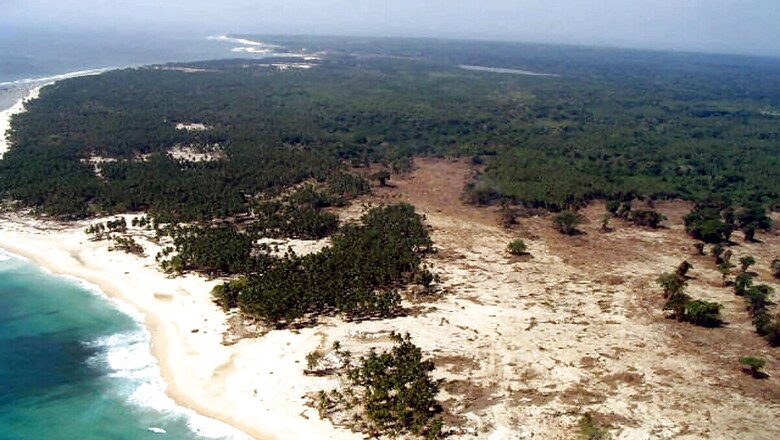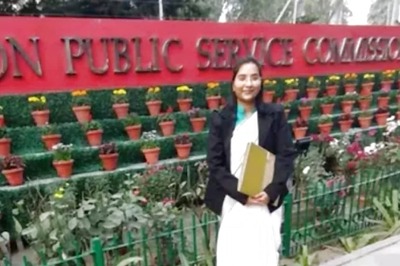
views
Miles deep in the rainforest of the Andamans, a small medical team was greeted by curious and joyful eyes of men wearing headbands and armbands made of wild fruits as well as women adorning themselves with bead jewellery.
Armed with a bow made of ‘chuiood’ (Sageraea elliptica) and arrows of areca wood, one of them, while expressing his happiness, said in Hindi, “Sahab aaya….sahab aaya…biscuit dega…TV dikhayega (Sir has come, he will give us biscuits, and he will show us television).”
Among them were a few children who surrounded the medical team and gave curious looks at a small briefcase carried by one of the medical staff with a red-cross emblem on it.
Welcome to the tribal reserve of the Jarawas along the Andaman Trunk Road. Its members are believed to be descendants of the Jangil tribe and known to be the first successful tribe to move out of Africa (based on their DNA tests) thousands of years ago. Primarily, they are hunter-gatherers and came to the Andamans about 60,000 years ago. They are one of several indigenous tribal groups living in the Andaman and Nicobar Islands in the Bay of Bengal. They are of short height, with dark skin and curly hair, resembling African Bushmen in appearance.
The Jarawas are no longer hostile to the outside world – they encountered similar experiences in the past when medical teams reached out to them for first-aid for their injuries, which they suffered while hunting and fishing. This medical care service was welcomed by the tribes people and they developed a sense of trust for the local medical staff as they believe that modern medicines heal their wounds faster as compared to their jungle remedies.
Now, when the world is grappling with the novel coronavirus pandemic, the local administration in Port Blair has conducted tests on nearly 280 Jarawa people and all of them have been found to be negative and healthy.
The decision to start testing Particularly Vulnerable Tribal Groups (PVTGs) in the Andamans was taken in the wake of Covid-19 spread among ten Great Andamanese tribe people. All of them have recovered and most of them have been sent to the Strait Island, which is earmarked for them. Meanwhile, on Tuesday, six members of a PVTGs tested positive for Covid-19, the Health Ministry said.
Speaking to News18.com, Dr Avijit Roy, nodal officer of Covid-19 in Andaman and Nicobar Islands, said, “We have tested nearly 280 Jarawa tribe people and the good news is all of them tested negative. They all are healthy and doing well. We are following the instructions of the administration and I must say that under the guidance of our chief secretary (Chetan Sanghi), we have done remarkably well in containing the virus in the islands.”
When asked about the challenges they face while conducting tests on these tribes, he said, “We have a dedicated medical team deployed at ‘health and wellness centre’ close to the reserve areas. Unlike other tribes, the Jarawas developed a sense of faith in the medical teams because of the medicines that heal their wounds faster. When our medical team visits their reserve territories, they ask for biscuits and ask our team to show their mobile phones. But we maintain all the protocol which is required while dealing with such tribes.”
Recently, chief secretary Sanghi tweeted, “Primitive Vulnerable Tribes are all safe. Every precaution taken to protect this heritage of humanity. Rumours cause more damage than the Pandemic.”
A few weeks ago, similar tests were conducted on nearly 35 Onge tribe people who are confined to Dugong Creek (earmarked for them). They are not considered as ‘uncontacted’ like the Sentinelese who live on the North Sentinel Island. The test reports of all the Onge came negative.
“One Onge tribe woman who is working as an Accredited Social Health Activist (ASHA) worker is assisting our team,” Roy said.
The Onges are also semi-nomadic and were fully dependent on hunting and gathering for food, but now the local administration provides them ration and clothes. Though they are not habitual to clothes but slowly they are developing a liking towards covering their bodies.
Over the years, since the establishment of penal settlement in 1858 by the British, the population of primitive tribes like Onge, Jarawa, Shompen, Great Andamanese, Onge and the Sentinelese were decimated due to various reasons, including epidemic (after coming in contact with the British soldiers), exploitation in exchange of alcohol and during confrontation with the Britishers.
Presently the populations of these Particularly Vulnerable Tribal Groups (PVTGs) in the Andaman and Nicobar Islands have been reduced to about 59 in case of the Great Andamanese, only 238 for Shompen, 520 for Jarawas, 120 for Onges and 50 for Sentinelese.
SA Awaradi, former director of tribal welfare, Andaman & Nicobar Tribal Research Institute, Port Blair, and a renowned tribal expert, said, “There is a need to ramp up initiatives to prevent interaction of tribal community people with the non-tribal. All tribes should be sent to their earmarked Islands. In case of the Great Andamanese, they should be sent to Strait Island after proper testing.”
On the Jarawa tribe, he said, “The first friendly contact with the Jarawa tribe was made in 1974. That was a medical team and since then they consider medical team members to be their friends because the ointment they gave cured their disease quickly. I interacted with them many times and found them less aggressive as compared to other tribes like the Shompen and Sentinelese.”
It was learnt that the local administration is also planning to conduct similar tests on the Shompen tribe (approx 230 members are left as per government statistics) but the challenge is they don’t like outsiders to enter their territory.
While sharing more about the Shompen, Awaradi said, “They are also great hunters and gatherers. They don’t trust anyone outside their community and are aggressive in nature. They mainly live on the Great Nicobar Island and prefer to make their huts on the hilltop unlike Jarawa (who make their huts inside the jungles on plains). As per government statistics, their population is nearly 230 but the exact number is still unknown because headcounts deep inside their territory could not be done. They belong to the Mongoloid-Negrito race.”
He said, “A few of them (Shompen) were contacted as part of their welfare mission. We have a Nicobarese tribe person who understands their language and he helps the team members reach out to them.”
Awaradi stressed that during this Covid-19 pandemic, utmost care should be taken to save these Particularly Vulnerable Tribal Groups as Andaman has already faced four epidemics in the past since penal settlement which led to mass deaths of tribals.
“These islands should be completely free from this virus. Since penal settlement in 1858 by the British, the population of primitive tribes like Onge, Jarawa, Shompen, Great Andamanese and the Sentinelese were decimated due to syphilis, influenza, measles, and gonorrhoea like epidemics. This pandemic is worse than the previous ones and the matter of concern is these tribal people are more prone to getting infected due to poor immune systems,” he said.
Awaradi worked extensively for tribal welfare in Andamans and he was among the first to visit the North Sentinel Island on January 4, 1991 and among the first to establish contact with the Sentinelese.















Comments
0 comment